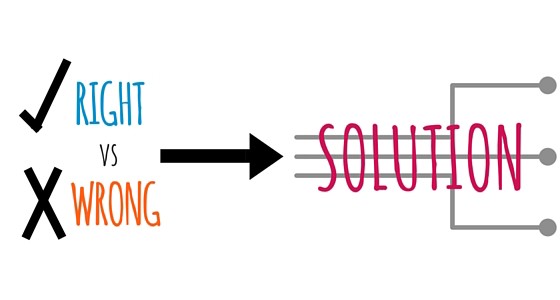A few conversations I’ve had lately have gotten me thinking about how being right often becomes a derailer for leaders.
In one conversation, two people were arguing about something completely inconsequential. They were both so adamant about being right about the subject that voices were raised, tension was high, and others in the room felt completely uncomfortable. The most interesting part was that they were both actually saying the same thing, just in different ways. It would have only taken one of them to stop and listen to realize it. Their focus on being right killed any attempt to understand what the other person was saying.
In another conversation, a leader shared some of the challenges she is having with members of her team. She asked me “am I crazy or am I right about this?” I missed a coaching opportunity here because the issue really isn’t about whether she’s right or crazy. Rather than trying to be right (and a team member be wrong), if we shifted the focus to understanding why there is a difference of opinion, why communication and expectations are a challenge, and probed deeper into the situation, we would likely find a root cause which has nothing to do with the current situation. That root cause could lead to a stronger, more aligned and productive team.
In many other situations, leaders are faced with different opinions, ways of working, and means to an end, than those they themselves would use. In most situations in business, there is not just one right answer, and in fact, by investigating many different ideas, we may even come to a better answer together.
When we’re focused on how we do things, how we see things, and on our own decisions being right, we lose sight of the ultimate outcome – an innovation, an improvement, a new benefit we hadn’t realized before.
Think about the times you’ve had a challenging encounter with someone. Were you focused on being right or on finding a solution? Sometimes the line seems fuzzy, and you need to take an unemotional look at the situation.
How to shift the focus from being right to finding a solution:
- Assume positive intent from the other person. In most cases, people don’t set out to do a bad job, to tell people lies, or to argue for the sake of argument. Assume that they are disagreeing with you with the intent to get to a positive outcome for you both.
- Remove the person from the situation. Often, these sorts of righteous, “must prove them wrong” scenarios occur with people we find difficult to deal with regularly. Imagine that the same feedback or argument was coming from your biggest supporter and fan. How would that change your reaction?
- Probe or ask the other person at least three questions, with the intent to understand their point of view. Here are a few that might help:
- That’s interesting. Tell me more about that. (for leaders who attend my workshops or coaching sessions, you know this is my favourite.)
- What is happening for you in this situation?
- What’s your perspective on this?
- What are the parts of this that we agree on?
- How did you come up with that outcome?
- Ask yourself what you’re trying to prove. Is your argument about being right or about solving the problem? Does the difference between your version of “right” and theirs really matter?
- Realize that conflict is healthy, when it’s handled well. The goal here isn’t to hold back on your feedback or ideas, but to open your mind to others as well. Debating a solution to a problem, as long as you’re truly hearing each other, can result in a much better solution.
Once you’ve done these things, you should both be more ready to shift to solution mode. At a minimum, you will understand their point of view better and will have removed some of your emotion from the conversation. You may still not agree, but you’ll be in a much better communication situation.
When do you find that your urge to be right is wrong?
If you enjoyed this post, you may also like:

